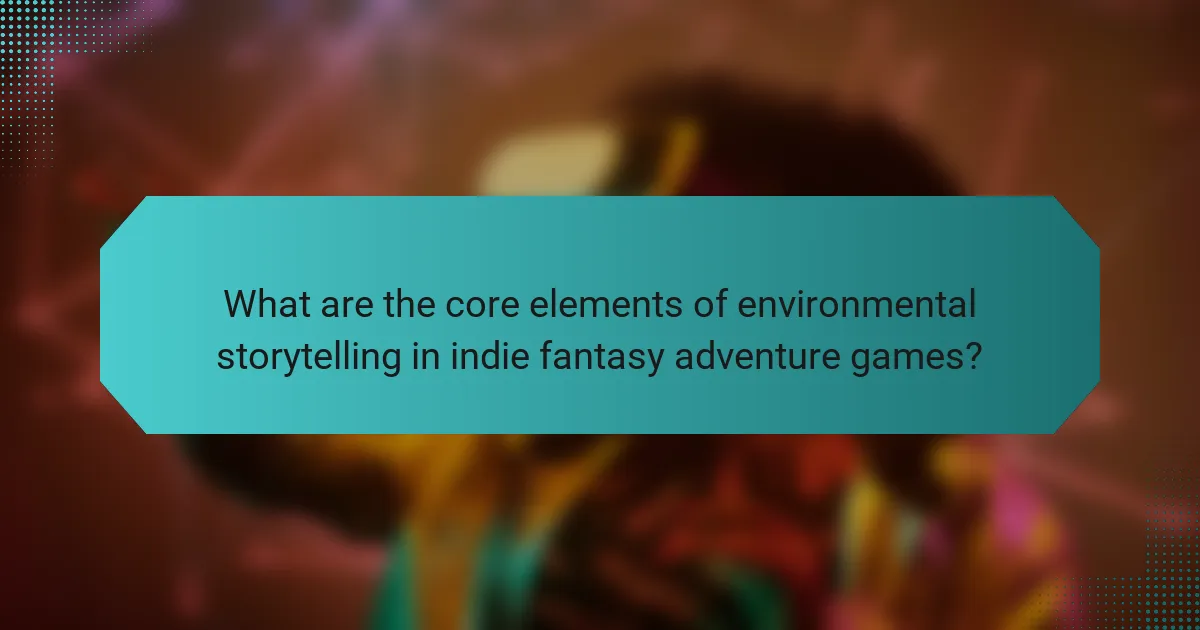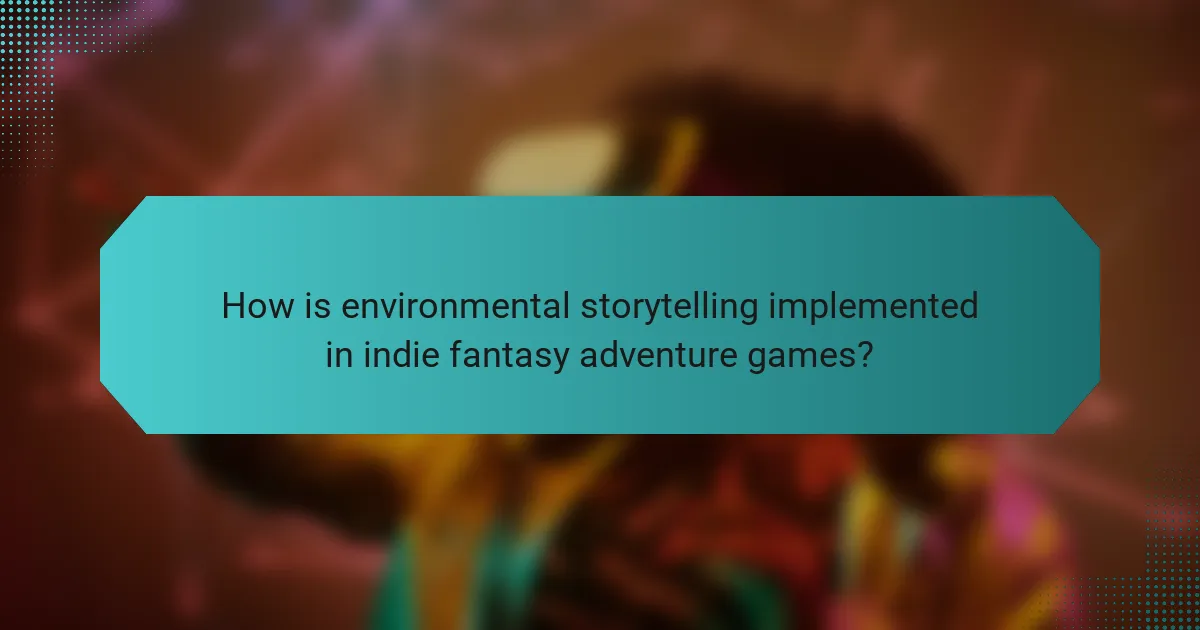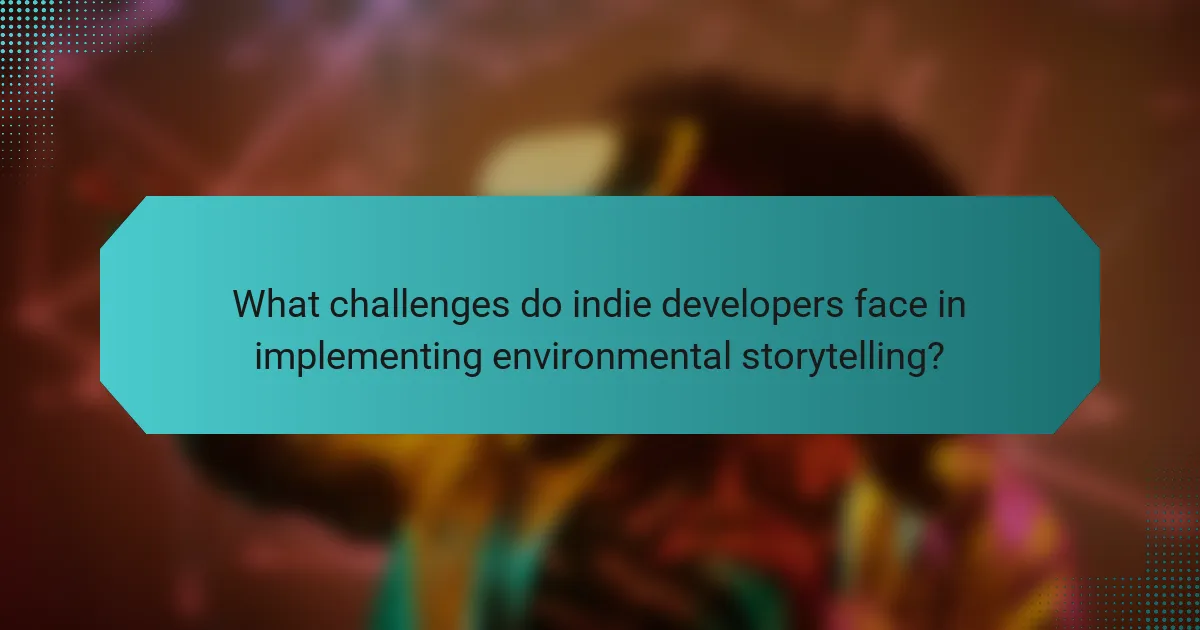Environmental storytelling in indie fantasy adventure games enhances player immersion and emotional connection. This article explores key elements like environmental design and player interaction, examines implementation strategies, and discusses the effectiveness of this narrative approach. It also highlights the unique challenges indie developers face and offers insights for enhancing storytelling through immersive world-building and interactive environments.

What are the core elements of environmental storytelling in indie fantasy adventure games?
Environmental storytelling in indie fantasy adventure games relies on immersive environments, visual cues, and narrative elements. Key elements include environmental design, interactive objects, character placement, and ambient storytelling. These features create a cohesive narrative experience, allowing players to engage deeply with the game world. Effective implementation enhances emotional connection, encourages exploration, and fosters player agency, making the storytelling experience unique and impactful.
How do narrative design and world-building contribute to environmental storytelling?
Narrative design and world-building enhance environmental storytelling by creating immersive experiences that engage players emotionally. They establish context, provide backstory, and enrich the game world, making it feel alive and interconnected. Effective narrative design uses character arcs and plot elements to guide players through environments, while world-building offers detailed settings that reflect the game’s themes and history. Together, these elements foster a deeper understanding of the game’s environment, encouraging exploration and emotional investment. This synergy results in a more compelling and memorable gameplay experience.
Which visual and auditory cues enhance storytelling through environment?
Visual and auditory cues like ambient sounds and environmental details significantly enhance storytelling in indie fantasy adventure games. These elements create immersive experiences that engage players emotionally and contextually.
Visual cues include detailed landscapes, unique character designs, and interactive objects that convey narrative without explicit dialogue. For instance, a ruined castle can suggest a backstory of conflict, while vibrant flora may indicate a thriving ecosystem.
Auditory cues such as background music and sound effects contribute to the atmosphere. Subtle sounds like rustling leaves or distant creatures enrich the environment, making it feel alive. Effective use of these cues can evoke specific emotions, guiding player reactions and decisions.
Together, these cues form a cohesive narrative experience that deepens player engagement, illustrating the power of environmental storytelling in game design.
What role do player interactions play in shaping the narrative experience?
Player interactions significantly shape the narrative experience by creating dynamic storytelling opportunities. These interactions allow players to influence plot outcomes, character development, and world-building elements. Engaging with NPCs and making choices can lead to unique story arcs, enhancing immersion. This player agency fosters emotional investment, making the narrative feel personal and impactful. Additionally, environmental storytelling elements, like hidden details and lore, become more relevant as players explore and interact, enriching their overall experience.

How is environmental storytelling implemented in indie fantasy adventure games?
Environmental storytelling in indie fantasy adventure games is implemented through immersive environments that convey narrative without explicit dialogue. Developers utilize visual cues, environmental design, and interactive elements to engage players.
Key elements include:
1. **Environmental Details**: Objects and scenery reflect the game’s lore and history, enhancing world-building.
2. **Player Interaction**: Players uncover stories through exploration and interaction with the environment, promoting engagement.
3. **Atmospheric Design**: Sound, lighting, and textures create an emotional connection, influencing player experience.
4. **Non-linear Storytelling**: Players discover narratives at their own pace, fostering a personalized journey.
This approach effectively deepens player immersion and emotional investment in the game world.
What are the common techniques used for integrating storytelling into game environments?
Common techniques for integrating storytelling into game environments include environmental cues, character-driven narratives, player choice impacts, and visual storytelling elements. Environmental cues use objects and settings to convey backstory. Character-driven narratives involve NPCs sharing lore, enhancing immersion. Player choice impacts create branching storylines, influencing outcomes. Visual storytelling elements utilize art and design to evoke emotions and themes. These techniques enhance engagement and deepen player experience in indie fantasy adventure games.
How do developers balance gameplay mechanics with narrative immersion?
Developers balance gameplay mechanics with narrative immersion by integrating environmental storytelling elements seamlessly into gameplay. This approach enhances player engagement and emotional connection.
Indie fantasy adventure games often utilize visual cues, character interactions, and world design to convey story elements. For example, a ruined castle may hint at past conflicts, encouraging exploration.
Additionally, gameplay mechanics like puzzles and quests can reinforce narrative themes. When players solve a puzzle related to a character’s backstory, it deepens their investment in the narrative.
Effective implementation requires careful planning to ensure that mechanics do not overshadow the story. A well-crafted balance allows players to experience the narrative organically through their actions.
Which tools and technologies are popular for creating immersive environments?
Popular tools and technologies for creating immersive environments include Unreal Engine, Unity, and Blender. These platforms offer advanced graphics, physics simulations, and extensive asset libraries, enhancing environmental storytelling in indie fantasy adventure games. Unreal Engine excels in photorealistic visuals, while Unity provides versatility and ease of use. Blender is favoured for its powerful modelling and animation capabilities.

What are the unique attributes of environmental storytelling in indie games compared to mainstream titles?
Indie games often utilize environmental storytelling in ways that differ significantly from mainstream titles. Indie developers frequently emphasize player agency, allowing for diverse interpretations of narrative elements. They often create unique worlds with rich lore embedded in the environment, promoting exploration and discovery. Additionally, the use of minimalistic design in indie games can enhance immersion, as players focus on subtle details that convey story. In contrast, mainstream titles may prioritise high production values, often sacrificing depth for visual spectacle. This unique approach in indie games fosters a more intimate and personal storytelling experience.
How does player agency influence narrative outcomes in indie games?
Player agency significantly shapes narrative outcomes in indie games by allowing players to make impactful choices. These choices enhance immersion and personal investment in the story. Environmental storytelling, a key element in indie fantasy adventure games, leverages player decisions to create unique experiences. The effectiveness of this storytelling method lies in its ability to adapt to player actions, thereby fostering a deeper connection between the player and the game world.
What innovative approaches have indie developers taken to storytelling?
Indie developers have embraced innovative storytelling approaches by integrating environmental storytelling techniques into their fantasy adventure games. These methods enhance immersion and player engagement through rich, interactive narratives that unfold within the game world.
One notable approach is the use of visual cues and environmental details to convey backstory. For instance, scattered artifacts and altered landscapes can hint at past events, allowing players to piece together the narrative organically. This technique encourages exploration and fosters deeper connections to the game world.
Another effective method is player-driven storytelling, where choices impact the environment and narrative progression. This dynamic interaction empowers players to shape their experiences, making each playthrough unique. Developers often implement branching paths or multiple endings based on player actions, enhancing replayability.
Additionally, sound design plays a crucial role in environmental storytelling. Ambient sounds and musical scores can evoke emotions and set the tone for different areas, guiding players’ experiences and enhancing narrative depth. This auditory layer complements visual storytelling, creating a cohesive atmosphere.
Overall, these innovative approaches demonstrate how indie developers leverage environmental storytelling to create compelling narratives that resonate with players, offering immersive experiences in fantasy adventure games.

How effective is environmental storytelling in engaging players in indie fantasy adventure games?
Environmental storytelling is highly effective in engaging players in indie fantasy adventure games. It immerses players in the game world, enhancing emotional connections and narrative depth. Unique environmental cues, such as visual design and interactive elements, communicate backstory and character development without explicit dialogue.
Games like “Journey” and “Firewatch” exemplify this method, using landscapes and objects to convey themes and emotions. As a result, players often report a stronger sense of agency and attachment to the game world. Indie developers leverage this technique, creating memorable experiences that resonate with players, increasing replayability and community engagement.
What metrics can be used to assess player engagement and emotional response?
Player engagement and emotional response can be assessed using metrics such as gameplay duration, player retention rates, emotional feedback surveys, in-game decision analysis, and social interactions. These metrics reveal how players connect with the story and environment in indie fantasy adventure games.
| Metric | Description |
|—————————|————————————————–|
| Gameplay Duration | Total time spent playing the game |
| Player Retention Rate | Percentage of players returning after first play |
| Emotional Feedback Surveys | Player responses to emotional impact questions |
| In-Game Decision Analysis | Tracking choices that reflect player emotions |
| Social Interactions | Engagement in community discussions or sharing |
How does environmental storytelling impact player retention and satisfaction?
Environmental storytelling significantly enhances player retention and satisfaction by creating immersive experiences. Engaging narratives and environmental cues allow players to connect emotionally with the game world. This connection fosters a sense of belonging, encouraging players to explore further. Games that effectively implement environmental storytelling often see increased player investment, leading to longer play sessions and higher satisfaction rates. By integrating rich details and lore into the environment, developers can create memorable experiences that resonate with players, ultimately improving retention.

What challenges do indie developers face in implementing environmental storytelling?
Indie developers face several challenges in implementing environmental storytelling. Limited budgets restrict the scope of world-building and asset creation. Time constraints often lead to prioritising gameplay mechanics over narrative depth. Additionally, smaller teams may lack specialised skills in narrative design, hindering the integration of storytelling elements. Finally, balancing player agency with story coherence poses a significant challenge, as developers strive to create engaging and immersive experiences.
Which common pitfalls should developers avoid when crafting narratives through environment?
Developers should avoid common pitfalls like neglecting environmental clues, failing to integrate narrative and gameplay, and overlooking player agency. These mistakes can diminish storytelling effectiveness and player immersion.
Neglecting environmental clues can lead to disjointed narratives. Players expect the environment to provide context and enhance storytelling. Failing to integrate narrative and gameplay can create a disconnect, making the story feel forced. Lastly, overlooking player agency can frustrate players, as they desire meaningful choices that influence the narrative.
How can budget constraints affect the quality of environmental storytelling?
Budget constraints can significantly diminish the quality of environmental storytelling in indie fantasy adventure games. Limited financial resources often restrict the scope of world-building, character development, and narrative depth. Developers may have to forego intricate environmental details, reducing immersion and player engagement.
Moreover, budget limitations can lead to fewer assets and less variety in environments, which are crucial for creating a rich storytelling experience. As a result, the overall effectiveness of environmental storytelling may suffer, impacting players’ emotional connection to the game world.

What are some best practices for enhancing environmental storytelling in indie fantasy adventure games?
To enhance environmental storytelling in indie fantasy adventure games, focus on immersive world-building, character-driven narratives, and interactive environments.
1. Create detailed lore that informs the setting and history, enriching player engagement.
2. Utilize environmental cues, like visual storytelling elements, to convey narratives without dialogue.
3. Design interactive objects that reveal backstory or lore when examined, fostering exploration.
4. Incorporate sound design that reflects the environment, enhancing atmosphere and emotional connection.
5. Implement subtle visual changes that indicate player choices, reinforcing narrative consequences.
6. Encourage player agency through branching paths that influence the environment and story outcomes.
How can developers create a cohesive narrative through environmental design?
Developers can create a cohesive narrative through environmental design by integrating storytelling elements into game environments. This involves crafting spaces that reflect the game’s lore, character backstories, and emotional tone.
Utilising visual cues like architecture, colour palettes, and environmental details can enhance immersion. For example, a dilapidated village may signify past conflict, while vibrant forests can evoke a sense of wonder.
Interactive elements, such as collectibles or environmental puzzles, can further engage players and reveal narrative layers. This approach fosters a deeper connection between players and the game world, enhancing overall storytelling effectiveness.
Ultimately, cohesive environmental design not only supports the narrative but also enriches player experience, making the world feel alive and meaningful.
What strategies can be employed to encourage player exploration and discovery?
Encouraging player exploration and discovery in indie fantasy adventure games can be achieved through immersive environmental storytelling. This includes creating rich, detailed worlds that hint at lore through visual cues, interactive elements, and hidden narratives.
Developing unique landmarks and diverse ecosystems can motivate players to explore. For example, placing ancient ruins or mysterious forests invites curiosity and rewards players with discoveries.
Incorporating dynamic environments that change based on player actions enhances engagement. This can lead to new paths or storylines that unfold as players explore.
Finally, integrating subtle clues and puzzles within the environment encourages players to think critically, fostering a sense of accomplishment when they uncover secrets.
Which community feedback mechanisms can improve storytelling effectiveness?
Community feedback mechanisms can significantly enhance storytelling effectiveness in indie fantasy adventure games. Engaging players through surveys, focus groups, and playtesting sessions allows developers to gather insights on narrative elements and emotional impact.
Implementing systems for player feedback, such as in-game prompts or forums, encourages continuous dialogue about story progression and character development. This iterative process helps refine narratives based on player experiences and preferences, ultimately leading to a more immersive and resonant storytelling experience.
Additionally, analysing player-generated content, such as fan fiction or mods, can reveal what aspects of the story resonate most, guiding future narrative choices. By valuing community input, developers can create richer, more engaging worlds that reflect player desires and enhance overall gameplay.